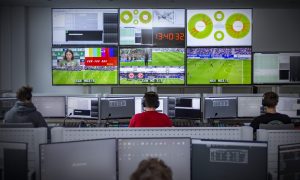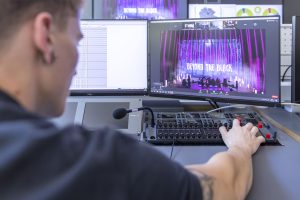SVG Tech Insight: Custom-Engineered Technologies and Remotely Managed Services for Large-Event Communications
This fall SVG will be presenting a series of White Papers covering the latest advancements and trends in sports-production technology. The full series of SVG’s Tech Insight White Papers can be found in the SVG Fall SportsTech Journal HERE.
Communications for today’s large-scale sporting and entertainment events are complex, and growing more so by the day. The technical challenges of in-venue production have been further complicated by the coronavirus pandemic and a greater need for physical distancing and remote work.
A remote operations center (ROC) addresses all these challenges and offers a flexible solution for meeting the evolving requirements of live production. This model not only simplifies implementation of sophisticated real-time communications, but also reduces users’ operational and equipment costs.
Leveraging centralized technical resources, a secure internal data center, and a network with global reach, the ROC enables provision of tailor-made technologies and supports comprehensive system management, freeing up users to focus on the match, concert, or other live event at the center of the production. Skilled operators remotely control, configure, and calibrate all system components in real time, ensuring maximum security, optimizing system configuration, and monitoring and maintaining audio and video quality.
The ROC also eliminates the need for extensive travel by technicians and engineers, reducing hospitality and transportation costs — as well as the user’s carbon footprint — while enabling implementation of appropriate distancing protocols. The facility can support single events or a dozen simultaneous events, with just one team of specialists working to maintaining consistent communications capabilities and quality throughout every event. Proactive monitoring at all times ensures that systems are ready to go as the match or show kicks off.
A Closer Look at the ROC
With state-of-the-art communications and networking equipment, the ROC model is setting a new standard for production of cost-effective, high-quality audio, and video transmissions for live events. Staffed 24/7 by a knowledgeable team and equipped with the latest gear, tightly integrated to ensure reliability, efficiency, and security, the ROC has the flexibility to address multiple applications and to adapt quickly — even instantly — to the end user’s changing needs.
Typical system components within the ROC include scalable, networked solutions for reliable communications and audio signal distribution, as well as integrated media signal distribution and processing. Multifunctional user interfaces that offer varied functionality (much like apps do on smartphones) give operators intuitive interfaces and just the right capabilities for different applications. Operators at the ROC configure, monitor, and maintain these systems along with antennae and wireless intercom systems deployed at the event venue.
Centralized monitoring and control with custom-engineered intercom technologies ensures that end users enjoy flexible, crystal clear communications from any point within the venue. Because every component is designed with full redundancy, the ROC is well-prepared for any potential system failures. Generator backup ensures that equipment at the ROC can operate independently of the power grid, in turn enabling continuous monitoring even if a power outage occurs.
Use Case: Communications in Live Sports
The ROC provides remote control, monitoring, and quality assurance during production for live sports such as football and motorsports. The setup enables crystal-clear communications and sharing of audio, video, and data information between the ROC and users onsite, such as referees, teams, and engine suppliers, and even allows remote access to onsite equipment such as Riedel’s Artist digital matrix intercom, Bolero wireless intercom, and MediorNet media signal distribution and processing system.
The operators in the ROC can control and configure all the system components such as aerials and radio equipment in real time, whether for one venue or for dozens. Thanks to proactive monitoring, operators are notified as soon as any piece of equipment fails. As a result, they can perform instant troubleshooting, or even make an onsite repair before onsite staff become aware of an issue.
On match or race days, the operators in the ROC make a range of adjustments to achieve the best possible sound quality. By filtering unwanted noise (crowds, engines, etc.) from the signals and by accommodating the varying volumes of speakers’ voices, intercom technicians can create the perfect audio mix.
Use Case: Remote Mastering for a Live-Streamed Concert
With the benefit of a worldwide MPLS backbone, hundreds of local partners, and local peering points, a ROC can support a wide variety of remote and distributed production applications. Serving as the communications and signal transmission hub, the ROC facilitates flexible collaboration between geographically distributed sites. One such use case is remote mastering for a live-streamed concert.
To unite performers, a mixing team, and a remote mastering studio, the ROC not only acts as a service provider, but also performs signal configuration, transmission, and monitoring to ensure streams move smoothly between venue and studio. Technicians at the venue can quickly connect a compact plug-and-play live event recording, mixing, and broadcasting system to the ROC via a WAN connection, then turn their focus on the music and let experts at the ROC worry about setup, communications, and signal flow.
This model allows musicians, mixing and mastering experts, and communications engineers to work together smoothly, even when they are a world apart, to deliver a perfect sound experience to a global audience.
Use Case: Charity and Special Events
The coronavirus pandemic has driven visitors away from museums, zoos, and other institutions that typically welcome a steady stream of visitors. As these organizations work to stay connected with their members and the larger public, the ROC offers a fun, simple, and economical solution: a live stream from a special event.
The resources afforded by the ROC can, for example, help a local zoo share a special event via a live stream. Expecting a healthy birth from a notable resident, the zoo need only have a series of CCTV cameras installed, connect to the ROC, and let technicians monitor and control cameras 24/7 as the event unfolds. Because the ROC houses almost all technical resources, as well as a team to configure, monitor, and maintain the live stream, the burden on the zoo (or similar institution) remains small. Given the popularity of cute newborn animals, this one-time investment in a special event can boost visibility and remind people to visit in person when safety permits.
Summary
As these three use cases demonstrate, the ROC can deliver value in many different ways. Providing the systems, service, and knowledge critical to managing advanced communications and signal transmission, the ROC makes it easy for people and organizations to implement sophisticated solutions that help to drive their business.
The ROC enables a full-service model that reduces the personnel and logistical production effort onsite while enabling unrestricted transmission security and high service quality. While this approach is ideal for a world in which remote work has become a must, it is valuable in any production environment that can benefit from professionally managed communications based on sophisticated intercom and signal transmission technologies.


